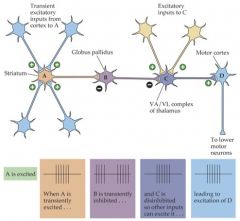![]()
![]()
![]()
Use LEFT and RIGHT arrow keys to navigate between flashcards;
Use UP and DOWN arrow keys to flip the card;
H to show hint;
A reads text to speech;
19 Cards in this Set
- Front
- Back
|
What are the cortical exceptions to the input to the basal ganglia?
|
primary auditory cortex
primary visual cortex |
|
|
What is the main output from the striatum
|
globus pallidus and the substantia nigra pars reticulata
|
|
|
Describe the cellular organization of the striatum
|
1. receives excitatory input from all areas of the cortex (glutamate, dopamine from SN)
2. "striosomes" receive limibic input <-- impact on memory 3. most cells are medium spiny neurons, major output is GABAergi, quiet at baseline 4. tonically active inhibitory interneurons |
|
|
What are the inputs and outputs of medium spiny neurons? Where are MSN found?
|
input: glutamate, dopamine (on dendritic shaft, modulatory)
output: GABA found in the striatum of the basal ganglia |
|
|
What is the role of the basal ganglia?
|
The basal ganglia (or basal nuclei) are a group of nuclei in the brains of vertebrates, situated at the base of the forebrain and strongly connected with the cerebral cortex, thalamus and other areas. The basal ganglia are associated with a variety of functions, including motor control and learning. Currently popular theories implicate the basal ganglia primarily in action selection, that is, the decision of which of several possible behaviors to execute at a given time.
|
|
|
Describe the disinhibitory circuit of the basal ganglia
|

|
|
|
What are the roles of the ventral striatal system?
|
1. wired in parallel with the dorsal system
2. more involved in behavior and cognition 3. abnormalities may underlie psych disorders including addiction and schizophrenia |
|
|
Where is the ventral striatum located? To where is it connected?
|
Located ventral to the striatum and consists of the nucleus accumbens and the olfactory tubercle (just deep to the anterior perforated substance)
Afferents arise from the limbic cortex including the hippocampus, amygdala, piriform cortex, cingulate cortex and entorhinal cortex |
|
|
What is the function of the cerebellum?
|
"modulate movement"
ispilateral influence on rate, range, force, and direction also appears to be involved in learning and memory |
|
|
What is a basket cell?
|
inhibitory interneurons that contact distant purkinje cells - inhibit row next to row that is being excited.
They are in the molecular cell layer |
|
|
What is the golgi cell?
|
cell bodies are in the granular layer, indirect action on the purkinje cells by affecting granule cell activity
|
|
|
What is a purkinje cell?
|
Purkinje cells are the source of output from the cerebellar cortex
|
|
|
What are the functions of the descending motor tracts?
|
May directly influence alpha motor neurons in the corticospinal tract
Modulate reflex excitability via interneuron modulation of alpha motor neurons |
|
|
Which descending tracts run in the anterior funiculus of the spinal cord? Which are in the lateral?
|
anterior: tectospinal, medial vestibulospinal, pontine reticulospinal
lateral: rubrospinal, lateral vestibulospinal, medullary reticulospinal, corticospinal |
|
|
Compare the general functions of the tracts running in the ventral funiculus from those in the lateral
|
ventral: movement of the head and neck
lateral: gross muscle movement |
|
|
Which tracts run in the MLF? What do they have in common?
|
tectospinal, medial vestibulospinal, pontine reticulospinal
movement of head and eyes |
|
|
What is the role of the vestibulospinal fibers?
|
connect the vestibular nuclei to the spinal cord/sycn body position to vestibular input
|
|
|
What is decerebrate posture? Decorticate?
|
Decerebrate - lesion between the red nucleus in the midbrain and the vestibular nuclei of the medulla,
Decorticate - lesion between the cortex and the red nucleus. leaves the rubrospinal tract in charge - hug hands up, pointed toes |
|
|
What are the functions of the reticulospinal tract?
|
The medullary reticulospinal tract sets muscle tone, controls preganglionic autonomic motor neurons, descending control of pain transmission
pontine reticulospinal tract: coordinates head movement with eye movement |

